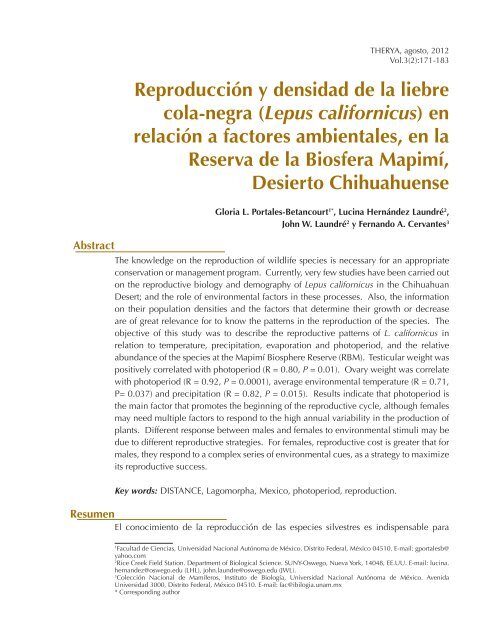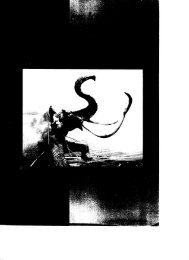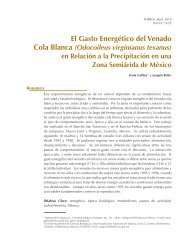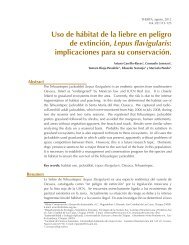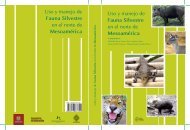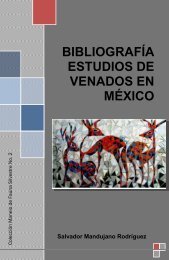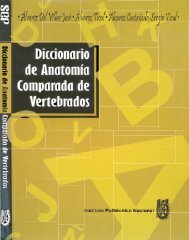Therya agosto 2012.indb - AMMAC: Acerca de la Asociación ...
Therya agosto 2012.indb - AMMAC: Acerca de la Asociación ...
Therya agosto 2012.indb - AMMAC: Acerca de la Asociación ...
You also want an ePaper? Increase the reach of your titles
YUMPU automatically turns print PDFs into web optimized ePapers that Google loves.
Abstract<br />
Resumen<br />
THERYA, <strong>agosto</strong>, 2012<br />
Vol.3(2):171-183<br />
Reproducción y <strong>de</strong>nsidad <strong>de</strong> <strong>la</strong> liebre<br />
co<strong>la</strong>-negra (Lepus californicus) en<br />
re<strong>la</strong>ción a factores ambientales, en <strong>la</strong><br />
Reserva <strong>de</strong> <strong>la</strong> Biosfera Mapimí,<br />
Desierto Chihuahuense<br />
Gloria L. Portales-Betancourt 1* , Lucina Hernán<strong>de</strong>z Laundré 2 ,<br />
John W. Laundré 2 y Fernando A. Cervantes 3<br />
The knowledge on the reproduction of wildlife species is necessary for an appropriate<br />
conservation or management program. Currently, very few studies have been carried out<br />
on the reproductive biology and <strong>de</strong>mography of Lepus californicus in the Chihuahuan<br />
Desert; and the role of environmental factors in these processes. Also, the information<br />
on their popu<strong>la</strong>tion <strong>de</strong>nsities and the factors that <strong>de</strong>termine their growth or <strong>de</strong>crease<br />
are of great relevance for to know the patterns in the reproduction of the species. The<br />
objective of this study was to <strong>de</strong>scribe the reproductive patterns of L. californicus in<br />
re<strong>la</strong>tion to temperature, precipitation, evaporation and photoperiod, and the re<strong>la</strong>tive<br />
abundance of the species at the Mapimí Biosphere Reserve (RBM). Testicu<strong>la</strong>r weight was<br />
positively corre<strong>la</strong>ted with photoperiod (R = 0.80, P = 0.01). Ovary weight was corre<strong>la</strong>te<br />
with photoperiod (R = 0.92, P = 0.0001), average environmental temperature (R = 0.71,<br />
P= 0.037) and precipitation (R = 0.82, P = 0.015). Results indicate that photoperiod is<br />
the main factor that promotes the beginning of the reproductive cycle, although females<br />
may need multiple factors to respond to the high annual variability in the production of<br />
p<strong>la</strong>nts. Different response between males and females to environmental stimuli may be<br />
due to different reproductive strategies. For females, reproductive cost is greater that for<br />
males, they respond to a complex series of environmental cues, as a strategy to maximize<br />
its reproductive success.<br />
Key words: DISTANCE, Lagomorpha, Mexico, photoperiod, reproduction.<br />
El conocimiento <strong>de</strong> <strong>la</strong> reproducción <strong>de</strong> <strong>la</strong>s especies silvestres es indispensable para<br />
1Facultad <strong>de</strong> Ciencias, Universidad Nacional Autónoma <strong>de</strong> México. Distrito Fe<strong>de</strong>ral, México 04510. E-mail: gportalesb@<br />
yahoo.com<br />
2Rice Creek Field Station. Department of Biological Science. SUNY-Oswego, Nueva York, 14048, EE.UU. E-mail: lucina.<br />
hernan<strong>de</strong>z@oswego.edu (LHL), john.<strong>la</strong>undre@oswego.edu (JWL).<br />
3Colección Nacional <strong>de</strong> Mamíferos, Instituto <strong>de</strong> Biología, Universidad Nacional Autónoma <strong>de</strong> México. Avenida<br />
Universidad 3000, Distrito Fe<strong>de</strong>ral, México 04510. E-mail: fac@ibilogia.unam.mx<br />
* Corresponding author


